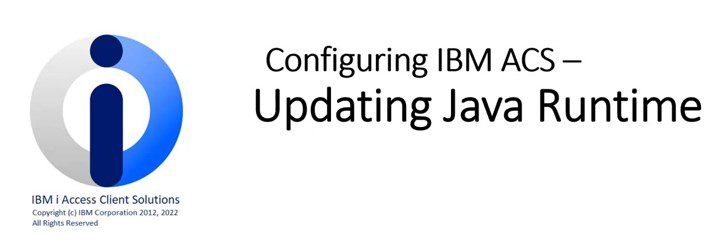As organizations embrace modern IT practices, the role of Java in various software solutions becomes a subject of curiosity.
In this blog, we dive deep into the realm of IBMi Access Client Solutions (ACS) to answer a common query:
“Does it need Java?“
Introduction
IBMi Access Client Solutions (ACS) is a powerful and essential tool for managing and accessing your IBMi (formerly known as AS/400 or iSeries) system. With ACS, you can manage your IBM i database and develop applications, simplify system administration, and manage your applications.
Understanding IBMi ACS
IBMi Access Client Solutions (ACS) provides a comprehensive set of tools and utilities for managing and interacting with IBMi systems. The app serves as a unified platform for developers, system administrators, and end users that allows them to perform tasks including:
1. 5250 Emulation: ACS offers a robust 5250 emulator, allowing users to access green-screen applications on the IBMi system.
2. Database Management: You can manage and query your IBM i databases using the SQL scripting tool within ACS.
3. Integrated File System (IFS) Support: ACS facilitates easy navigation and management of the IFS, enabling file transfers, directory browsing, and more.
4. System Administration: ACS provides system administrators with tools for configuration, monitoring, and maintenance of IBMi systems.
5. Application Development: Developers can utilize ACS to develop, debug, and maintain applications on the IBM i platform.
Overall, ACS makes it easier to manage and administer the IBMi system, which makes it a crucial tool for IBMi users.
Now, let’s address whether Java is a prerequisite for running IBMi ACS.

The Role of Java in IBMi ACS
As a Java application, IBMi ACS is heavily dependent on Java for its backend architecture. Java isn’t required on the client side (your local computer) to run ACS, but it depends on the ACS components you intend to use.
Features in ACS that require Java:
- Database access: ACS includes tools like Database Navigator and SQL Performance Center which enables you to interact with IBMi Database. To connect to DATABASE, execute queries, and analyze performance metrics, these tools rely on JAVA.
- Data transfer: ACS allows the transfer of data Between IBMi systems and other platforms. Java in IBMi is used to handle data conversions, file formatting, and transfer operations during this data transfer.
- Printer Output management: ACS provides print and output management capabilities and allows management of spooled files on IBMi. It may be necessary to install JAVA to use some advanced features, such as converting spool files into PDFs.
- 5250 Emulation: ACS offers a 5250 emulator, which allows it to interact with green screen applications on IBMi. To render the 5250 display and handle the user input, the emulator component makes use of JAVA.
Features in ACS that don’t require Java:
- Integrated File System (IFS): ACS includes an IFS navigator that enables users to navigate, manage, and transfer files and directories within the Integrated file system of IBMi.
- Performance Data Investigator: The Performance data investigator (PDI) is a feature in IBMi ACS that provides performance analysis and monitoring capabilities for IBMi systems.
- IBMi Navigator for i: It is a key component of IBMi ACS. For managing and administering IBMi systems, this tool provides a comprehensive and intuitive Graphical User Interface (GUI).
Although some features might need Java, the essential ACS features – such as system connectivity, user profile management, and simple system navigation can be used without Java dependencies.

The Significance of JAVA in ACS:
- The presence of Java on a system is indeed a consideration when using IBMi ACS. It is important to note, however, that Java is not a requirement for ACS.
- Due to its Java-based architecture, ACS utilizes Java technology to enable certain features.
- In IBMi’s ACS installation packages, the Java Runtime Environment (JRE) is included to provide users with the Java components they need without requiring them to install or configure them separately.
Advantages of including Java with ACS
- Simplified installation: The Java components required with ACS eliminate the need for users to install and configure Java separately. This eliminates compatibility issues as well.
- Version management: In the ACS installation package, there is a Java version that is compatible with ACS. It eliminates the need for manual version control and ensures that users are running the most recent version of Java.
- Enhanced Functionality: Java provides ACS with a strong foundation, which allows the software to deliver a wide range of powerful features and tools. It enables ACS to use Java libraries and frameworks, making the integration of different system components
Conclusion
In summary, IBMi Access Client Solutions (ACS) is a versatile tool for managing and interacting with IBM i systems. While Java is an integral part of the ACS architecture, its requirement on the client side depends on the ACS interface you choose to use. The web-based and mobile versions of ACS do not necessitate Java, making them accessible to a broader range of users.
Ultimately, the choice of ACS version depends on your specific needs and preferences. Whether you opt for the full client, web-based ACS, or mobile app, you can effectively manage your IBMi system without the complexities of Java installation if it’s not already present on your client machine.




